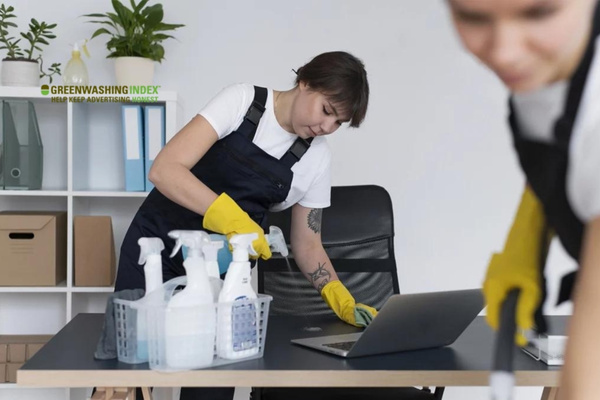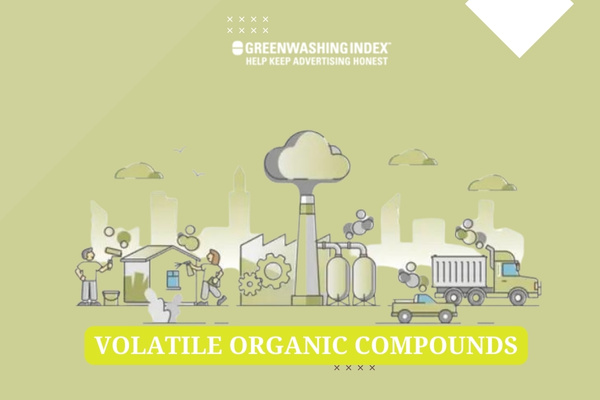Have you ever thought about what’s lurking in the air of your home? You know, the stuff you can’t see but could harm you and your loved ones? Well, those invisible threats are often volatile organic compounds or VOCs.
They sneak into our homes without a knock on the door or a ring of the bell. I’m here to pull back the curtain on these sneaky invaders to help keep your sanctuary safe and clean.
Understanding VOCs is crucial for keeping our homes and the environment safe. Simply put, they’re chemicals that easily turn into gases at room temperature. We find them in everyday items like paints, cleaning supplies, and even furniture.
These compounds can escape into our indoor air and sometimes join forces with outdoor pollution to create bigger problems
What Are Volatile Organic Compounds (VOCs)?
When I think of Volatile Organic Compounds or VOCs, I picture them as tiny culprits that can hide in many everyday products around us. VOCs definition is simple: they are chemicals that vaporize at room temperature and can be harmful to both our health and the environment.

Many common items in our homes, like paints, cleaning supplies, and even some cosmetics, release these compounds into the air we breathe. The science behind how VOCs affect us may sound complex, but it’s important to understand why they matter.
To get a clear idea of what VOCs are about, let’s break down what Volatile Organic Compounds actually stand for:
- Volatile: This word tells us that these compounds can easily turn into gases or vapors.
- Organic: In this case, it means these substances contain carbon in their chemical makeup.
- Compounds: A compound is simply something made up of two or more elements.
So when we talk about Volatile Organic Compounds, we’re talking about a wide range of chemicals that have these properties and can be found indoors and outdoors. You may have come across them when you smell the fresh paint on walls or the scent of cleaning products.
Some well-known examples include:
- Formaldehyde
- Benzene
- Toluene
And where do they come from? Well, here are a few everyday VOC sources:
- Building materials like carpets and adhesives
- Home products such as air fresheners and moth repellents
- Office equipment including copiers and printers
- Cigarette smoke
The Science Behind VOC Emissions
Understanding how VOC emissions work starts with acknowledging that air isn’t just empty space – it’s a fluid filled with small particles like dust, pollen, and yes—Volatile Organic Compounds. These sneaky particles emit from various sources without us seeing them.
Here’s how indoor air quality gets hit by VOC emissions:
- Use: Whenever we use products containing VOCs (like spraying an aerosol), we directly release them into our indoor environment.
- Evaporation: Products stored in open containers or even closed ones not sealed properly allow vapors to escape continuously into our living space.
- Reaction: Sometimes two harmless chemicals might react together to form potentially harmful VOCs once released into the air.
This differs quite a bit from outdoor pollution because while both indoor and outdoor environments contain Volatile Organic Compounds:
- Indoors: We face higher concentrations due to lower ventilation compared to the vast openness outside.
- Outdoors: The sun plays a big role by breaking down some types of those compounds; hence levels tend to be lower unless near industrial areas where emissions are more concentrated.
Being clued up on what Volatile Organic Compounds are is crucial for ensuring not just my home but also my local environment is safer because clean air isn’t something visible I can protect—it needs my understanding first so I can then reduce sources of pollutants wisely within my control.
Also Read: Compost Flies Uncovered: Solve Your Organic Waste Riddle!
The Prevalence of Volatile Organic Compounds in Our Homes
Volatile Organic Compounds, or VOCs, are very common in our homes. We may not see them, but they’re often there. So what exactly are they? In simple words, VOCs are chemicals that can easily turn into gases at room temperature.

Identifying Common Household Sources of VOCs
At home, we have many different things that can give off VOCs. Understanding where these chemicals come from helps us control them better and keep our indoor air clean. Here is a list of products or materials in homes that might emit VOCs:
- Paint and varnishes: When we paint our walls or furniture, it smells strong because of the VOCs released into the air.
- Cleaning supplies: Many cleaning products have chemicals that also release VOCs.
- Air fresheners: These smell nice but can let out a lot of these compounds.
- Building materials: Things like plywood or glue used for making fixtures can contain high levels of VOCs.
- Upholstery and carpets: New carpets or furniture may release these compounds too.
- Cosmetics: Some beauty products have chemicals linked to volatile organic compounds.
- Hobby supplies: Items like adhesives, glues, and other craft materials might also be sources.
Did you know even printers and copiers at home could add to the amount of volatile organic compounds in our indoor space? It’s quite surprising how many everyday items could be affecting the air quality around us.
How to Detect Volatile Organic Compounds at Home?
Sometimes you might wonder if there are high levels of indoor VOCs in your house. How do you figure it out? Here’s some advice on identifying signs:
- Smell: If you notice a strong chemical smell after opening up new products or using certain cleaners, this could be a clue about high levels.
- Physical Reactions: Feeling dizzy or getting headaches when using products inside your home? That might mean lots of volatile organic compounds are present.
- Air Quality Monitors: You can buy devices specifically made to measure the level of different things in your air – including volatile organic compounds.
It’s crucial we pay attention to these signs because long-term exposure to high levels could affect our health.
Using common sense helps too: If it smells very strong and artificial, I would guess it likely has lots of chemicals that will turn into gases (VOCs) floating around after use.
Caring about our indoor air is part of keeping ourselves healthy – just as much as diet or exercise! Plus by controlling volatile organic compounds inside our homes, we help protect nature outside too – making sure there’s less pollution going back into the environment from within our little havens.
Also Read: Maggots in Compost: Why They’re Actually Good!
Health Risks Linked with Exposure to Volatile Organic Compounds
When I talk about Volatile Organic Compounds or VOCs, I am speaking of certain chemicals. These are around us in the air we breathe, often coming from everyday items. It’s important to know they can be harmful because they may affect our health in bad ways.

Short-term Health Effects of VOC Ingestion or Inhalation
Right after someone breathes in VOCs, their body might react immediately or within a few hours. Here’s what could happen:
- Eye irritation: The eyes might start watering and feeling sore.
- Nose and throat discomfort: It feels like a cold, with a stuffy nose and an itchy throat.
- Headaches: A pounding pain might start in the head.
- Dizziness: One could feel lightheaded or as if they are spinning even when still.
- Asthma symptoms: For those with asthma, breathing becomes harder after being around these compounds.
- Nausea and vomiting: Feeling sick to the stomach is another sign that something isn’t right.
All these signs tell us that being around too many VOCs isn’t good for anyone.
Long-term Health Implications of Chronic Exposure to VOCs
What if someone keeps being around VOCs for a long time? Well, it’s not great news either. Here are some scary things that might happen:
- Cancer risk increases: There’s worry about some types of cancer tied back to these compounds.
- Liver damage: The liver works hard cleaning out bad stuff from our bodies, but VOCs can tire it out or hurt it badly over time.
- Kidney problems: Like the liver, kidneys may get hurt too if one keeps taking in lots of these chemicals.
- Central nervous system harm: This is about our brains and nerves; lasting harm here can change how well we think or move.
These issues don’t show up right away but think about them like a slow poison. Over many days and years, little by little, my health could take serious hits from breathing in those harmful air bits called Volatile Organic Compounds.
Understanding these risks helps me remember why I need to keep my home safe from too many VOCs – for my family’s wellness now and for years ahead.
Also Read: Cotton Biodegradability: Eco-Friendly or Ecological Burden?
Strategies for Reducing Indoor Levels of Volatile Organic Compounds
When it comes to keeping my home safe and healthy, I know how important it is to pay attention to the air we breathe. That’s why I want to talk about Volatile Organic Compounds, or VOCs for short.
These are chemicals that can escape into the air from many everyday items. They could be bad for our health and our environment. So, let’s look at some simple steps we can take to get fewer VOCs in the air in our homes.
Tips for Minimizing Exposure in Your Living Spaces
To reduce indoor levels of Volatile Organic Compounds, here’s what I do:
- Ventilate My Home:
- Open windows and doors when the weather allows.
- Use exhaust fans in the kitchen and bathroom.
- Check Labels:
- Look for products that say “low-VOC” or “VOC-free”.
- Choose paints and finishes that have fewer chemicals.
- Store Safely:
- Keep things like paints, solvents, and cleaners in sealed containers.
- Store these items outside of my living space if possible.
- Buy Smart:
- Get furniture made from solid wood instead of pressed wood products.
- Opt for natural fibers in carpets and curtains which often have lower VOC content.
- Keep It Clean:
- Regularly clean floors with a damp mop.
- Use a vacuum cleaner with a HEPA filter to trap dust that might hold VOCs.
- Be Plant-friendly:
- Add more houseplants – they can help clean the air (but remember some plants may not be safe around pets).
- Manage Humidity:
- Use a dehumidifier because moisture can help some VOCs stay in the air longer.
Following these steps helps make sure I am doing what I can to keep levels of volatile organic compounds low inside my home.
Advanced Methods for Controlling Ambient Air Quality at Home
Now let’s talk technology! Here are some modern ways I use to manage air quality:
- Install Air Purifiers:
- Get an air purifier with an activated carbon filter – this helps catch chemicals from the air.
- Monitor Air Quality:
- Use devices that tell me what’s in my home’s air so I know what steps to take next.
- Upgrade Ventilation Systems:
- Invest in better airflow systems like heat recovery ventilators (HRVs). These bring fresh outdoor air inside while keeping the temperature comfortable.
- Seal Leaks:
- Seal off any leaks around windows or doors where outdoor pollutants might enter.
By using these advanced methods along with those practical tips, managing Volatile Organic Compounds becomes much simpler — protecting both my health and our precious environment!
Also Read: Compost Bugs: Deciphering the Good from the Bad
Volatile Organic Compounds and Their Environmental Impact
Volatile Organic Compounds, or VOCs, are a kind of chemical that turns into gas at room temperature. This might sound technical, but it’s actually about stuff that can evaporate easily and get into the air we breathe. Think about the smell of a fresh coat of paint or the scent when you peel an orange; those are examples of VOCs getting into the air.
Global Environmental Concerns Associated with High Levels of Outdoor VOC Emissions
Outdoor emissions from these compounds impact air quality in a big way. They can travel far from their source and end up changing the quality of air in places they reach. This can affect not just one area, but many parts all over our planet.
- First off, factory smoke can contain lots of VOCs. When industries release these gases into the air, they join other pollutants that have already been there.
- Next up is traffic emissions. Cars and trucks give off many types of gases including harmful Volatile Organic Compounds.
- Another source is gas stations. When fuel is handled or transferred, some VOCs escape into the outside air.
- What’s more, even things like solvents used for cleaning or certain hobbies contribute to this issue by releasing these compounds too.
When all these sources add up together, they seriously hurt global environmental health.
Role In Climate Change And Smog Production
Now let’s dig deeper into how emitted Volatile Organic Compounds mess with our climate and cause smog:
- Chemical Reactions: These compounds go through changes when mixed with other gases in sunlight causing new pollution like smog to form.
- Smog isn’t just “fog” but a harmful mix that hangs around at ground level where people live and breathe.
- What does this have to do with climate change? Well:
- Heat Trapping: Some VOCs trap heat which can lead to warmer temperatures worldwide — think about making Earth like a greenhouse too hot for comfort.
- Ozone Layer Damage: Certain types interfere with how Earth’s protective sunscreen (the ozone layer) works.
By understanding what creates high levels of outdoor VOC emissions and recognizing their role in climate change and smog production, each person becomes more aware of why it’s so important to control what we put into our shared environment for our collective safety—and also for protecting nature which has no voice but suffers silently under such man-made pressures.
Sustaining an Eco-Friendly Approach Against Volatile Organic Compounds
As someone who deeply cares about the environment, I am always looking for ways to promote a healthy world. Volatile Organic Compounds, or VOCs, are everywhere and they affect both our health and the environment. So, it’s important for me to share what I know about using products that keep these compounds in check.
Guidelines for Using Low-VOC Products
When selecting products that limit emissions of VOCs into our homes and planet, here are some steps I follow:
- Read Labels Carefully: Many products will show if they are low in VOCs. Look for labels like “low-emission,” “non-toxic,” or “zero-VOC.” If a label says this, it generally means you’re choosing something better for indoor air quality and environmental safety.
- Choose Water-Based Over Oil-Based: Whether it’s paint or cleaning products, water-based ones tend to have lower levels of VOCs compared to their oil-based counterparts.
- Check Certifications: Organizations like Green Seal or EcoLogo provide certifications for products that meet environmental standards regarding emissions. Products with these seals are more trusted.
- Ask Experts: If you’re not sure which product is best, ask staff where you buy your paints, adhesives, or varnishes. They can point you towards eco-friendly choices.
- Ventilation Matters: Even with low-VOC products, make sure wherever you’re applying them is well-ventilated. This helps any small amounts of VOCs escape and keeps your air clean.
By sticking with these guidelines when buying home improvement items or cleaning supplies, we can reduce our contribution to the harmful effects caused by high levels of volatile organic compounds.
Encouraging Broader Community Action Against High-VOC Substance Abuse
Here’s how we can take steps as a community to address the problem:
- Educate Others: Share knowledge on what volatile organic compounds are and why they’re harmful. Inform neighbors about safer alternatives available in stores.
- Organize Local Events: Host a seminar on environmental safety focusing on reducing VOC use within homes and businesses around your area.
- Promote Safe Disposal Programs: Encourage proper disposal of high-VOC materials like paints and solvents through community hazardous waste programs.
- Support Environmentally Conscious Companies: When entire communities start buying low-VOC products over those releasing harmful substances into the air we breathe, companies producing high-emission goods will notice the shift in demand.
When groups of people come together focused on one goal – in this case cutting down high Volatile Organic Compound emission rates – it fosters broader progress toward improving overall indoor air quality as well as environmental safety at large.
FAQs
What exactly are ‘volatile organic compounds’?
Volatile organic compounds, or VOCs, are chemicals that easily turn into a gas at room temperature. They’re found in many everyday items like paints and cleaners.
How do volatile organic compounds affect my health?
Breathing in volatile organic compounds can cause health problems such as headaches, dizziness, or worse over time. Some may even harm your liver, kidneys, or brain if you’re exposed for too long.
Can I prevent the formation or release of volatile organic compounds at home?
Yes, you can cut down on VOCs at home. Use products with low VOC content and keep your space well-ventilated when using chemicals or products that might release these compounds.
What is considered a safe level of household exposure to volatile organic compounds?
There’s no clear “safe” level since sensitivity to VOCs varies from person to person. The key is to reduce your exposure as much as possible for better indoor air quality and environmental safety.
Conclusion
Throughout my exploration of Volatile Organic Compounds (VOCs), I’ve delved deep into their nature, sources, and the risks they pose. Recognizing the presence of VOCs in our homes and environment has moved me to action, showing how critical it is to safeguard our indoor spaces and the air we breathe.
The health impacts from VOC exposure—both short-term irritations and long-term conditions—underscore the urgency for awareness and preventive measures. By adopting simple strategies, such as being selective about household products, improving ventilation, or using air purifiers, we can significantly reduce our indoor VOC levels.
On a broader scale, understanding VOCs’ role in environmental challenges like smog formation and climate change illuminates the importance of community action against high-VOC substances.
Using low-VOC products not only benefits individual households but also contributes to reducing global emission rates. The collective effort towards eco-friendliness can lead to a healthier planet.



